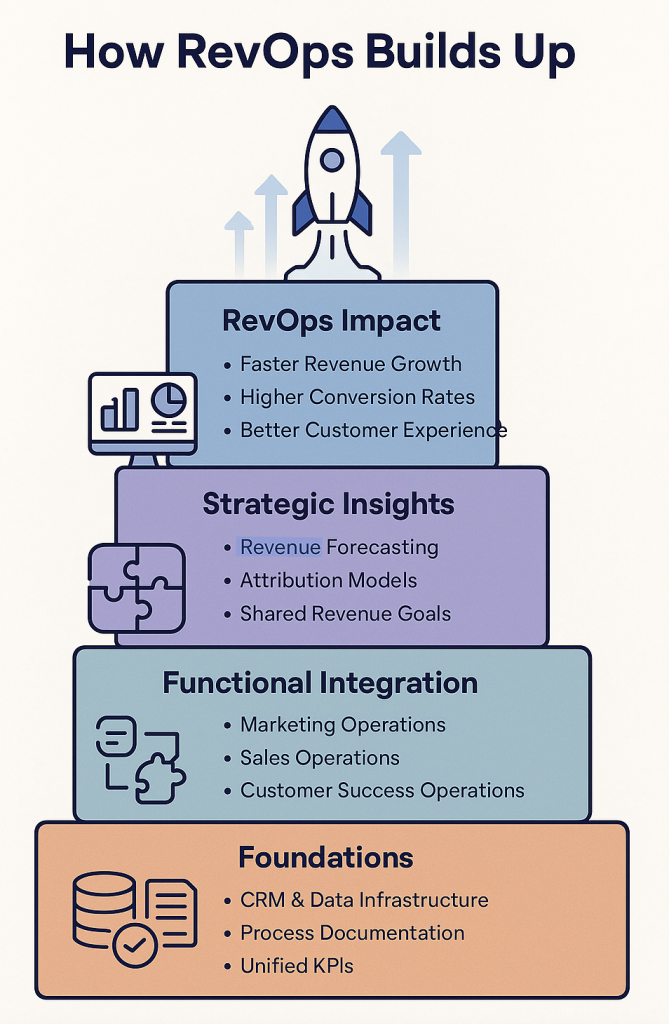The traditional business development model is under siege. For decades, marketing, sales, and customer success have operated as distinct kingdoms, each with their own metrics, cultures, and objectives. But the Revenue Operations (RevOps) revolution is demanding something radical: tear down the walls and unite these teams under a single banner of revenue generation.
This isn’t just an organizational chart shuffle—it’s a fundamental reimagining of how modern businesses drive growth.
The Old Guard vs. The New Order
In the traditional setup, the divisions were clear-cut. Marketing focused on lead generation and brand awareness. Sales concentrated on closing deals and hitting quotas. Customer success worked to retain and expand existing accounts. Each team operated in its own silo, with minimal overlap and often competing priorities.
Sales professionals, notorious for their independent streak, thrived in this environment. They worked alone, hunted their prey, and collected their commissions. Marketing celebrated campaign opens and click-through rates. Customer success measured churn rates and renewal percentages. Everyone had their lane, and everyone stayed in it.
But here’s the problem: this fragmented approach leaves massive gaps in the customer journey. Leads get lost in handoffs. Customers receive inconsistent experiences. Revenue opportunities slip through the cracks between departments.
The RevOps Paradigm Shift
Revenue Operations says “no more” to this dysfunction. In the new model, marketing doesn’t just heat up the funnel—they’re accountable for revenue. Sales doesn’t just close deals—they’re responsible for long-term customer success. Customer success teams don’t just prevent churn—they drive expansion revenue.
The game-changer? Aligned metrics and shared accountability.
Imagine this: Marketing receives bonuses not just for qualified leads, but for successful sales conversions. Sales professionals earn incentives based on customer retention rates, not just closed deals. Customer success teams are rewarded for identifying expansion opportunities that feed back into the sales pipeline.
This creates a beautiful symbiosis where everyone wins when revenue grows, and everyone loses when customers churn.
The Transformation Blueprint
So how do you transform decades of siloed thinking into a unified revenue machine? The answer lies in strategic disruption of the status quo.
Revolutionize Your KPIs
Start with the metrics. Scrap department-specific KPIs and replace them with revenue-focused measurements that span the entire customer lifecycle. Create shared dashboards where marketing, sales, and customer success can see how their efforts impact the complete revenue picture.
1. Embrace Matrix Organization
Break down rigid hierarchies and create cross-functional teams. Assign marketers to work directly with sales on specific accounts. Have customer success professionals participate in sales calls. Create project-based teams that include members from all three functions.
2. Implement Account-Based Everything
Treat each client as a strategic project with clear timelines, defined goals, and cross-functional leadership. Assign account teams that include marketing, sales, and customer success from day one. This creates natural collaboration and shared ownership of outcomes.
3. Redesign Compensation Structures
This is where the rubber meets the road. Create bonus structures that reward collective success over individual achievement. When marketing gets paid for sales success and sales get paid for customer retention, behaviors change rapidly.
Foster Cultural Integration
Organize regular cross-functional meetings, shared training sessions, and collaborative goal-setting workshops. Create physical or virtual spaces where these teams naturally interact and build relationships.
The Critical Success Factor: Cultural Alignment
Here’s the uncomfortable truth: RevOps transformation only works if your organization has the cultural foundation to support it. If your company culture already emphasizes collaboration, transparency, and shared success, the transition can be remarkably smooth.
But if your organization is struggling with recent changes, facing market pressures, or dealing with internal conflicts, forcing RevOps implementation can backfire spectacularly. Teams may resist change, competition between functions can intensify, and the entire initiative may crumble under its own weight.
The Bottom Line
The RevOps revolution isn’t just about organizational restructuring—it’s about creating a unified revenue engine where marketing, sales, and customer success work as one cohesive force. The key is aligning incentives, adjusting metrics, and fostering a culture of shared accountability.
When done right, the results can be transformative. Companies report improved customer experiences, increased revenue per customer, and faster growth rates. The individual contributor becomes part of something bigger: a revenue-generating machine that’s greater than the sum of its parts.
But remember: this transformation requires more than new org charts and adjusted KPIs. It demands a fundamental shift in how your organization thinks about revenue generation, customer relationships, and team collaboration.
Are you ready to break down the silos and embrace the RevOps revolution? The future of business development depends on it.
The transition from traditional, siloed operations to Revenue Operations represents one of the most significant shifts in modern business development. Success requires careful planning, cultural alignment, and the courage to disrupt established patterns that may have worked in the past but limit future growth potential.

